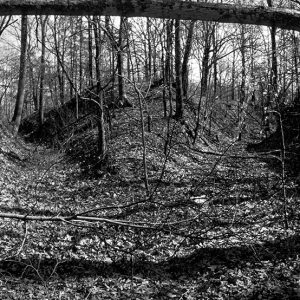calsfoundation@cals.org
Wittsburg Fortification
The Wittsburg Fortification is an earthen redoubt built in July 1863 at the junction of the Wittsburg to Batesville, Mount Vernon, and Madison roads to protect Union cavalrymen as they received supplies on the St. Francis River at Wittsburg (Cross County) during the Little Rock Campaign of 1863.
Union horsemen led by Brigadier General John Wynn Davidson crossed the St. Francis River at Chalk Bluff on July 19, 1863, to confront a reported Confederate force under Major General Sterling Price that was said to be heading north up Crowley’s Ridge to invade Missouri. Davidson’s column of 6,000 men, failing to find Price’s phantom army, continued down the ridge, reaching Jonesboro (Craighead County) on the evening of July 24.
The cavalrymen spread across Crowley’s Ridge, skirmishing with Confederate horsemen and seeking food and water in the hot summer weather in an area that was not sympathetic to the Union cause. Trooper A. W. M. Petty of the Third Missouri Cavalry (US) wrote in his diary, “Weather very warm, blackberries very scarce, and Union folks quite as much so,” and artilleryman Robert T. McMahan of the Twenty-Fifth Ohio Battery wrote that “our fast marching…is for grub.”
Davidson sent a patrol to Helena (Phillips County) to request supplies from the Union garrison of the Mississippi River town, while the rest of the Union troopers continued down Crowley’s Ridge. Many of them had reached Wittsburg, the head of navigation on the St. Francis River, by July 29, and Davidson ordered fortifications built on the high ground above the town to protect the troops from Confederate attack. McMahan wrote in his diary on July 29: “Commenced fortifying the brow of the hill look[ing] toward Jacksonport, details for labor are much from the cavalry. Are cutting down the timber on the side hill and constructing some kind of a stockade. Openings left for the guns[,] ditch on the outside.” The next day, McMahan noted simply: “Finished fortifying this evening.”
On July 30, a small steamboat, the Hamilton Belle, arrived from Helena with a load of supplies for the hungry Yankee troops. Davidson’s command left Wittsburg on August 1 with a new mission: Federal commanders had decided the time was ripe to mount an attack on the Confederate state capital at Little Rock (Pulaski County). Davidson would be joined by about 6,000 infantry under Major General Frederick Steele consisting of troops from the Helena garrison and others fresh from the recent Union capture of Vicksburg, Mississippi. Davidson’s troopers would bear the brunt of the fighting in the campaign, though, facing Confederate cavalry at Brownsville (Lonoke County), Bayou Meto, and Fourche Bayou before maneuvering Price’s Rebels from their works on the north side of the Arkansas River and capturing Little Rock on September 10, 1863.
Wittsburg would witness one more noteworthy event during the Civil War. Following the collapse of Confederate armies east of the Mississippi, Brigadier General M. Jeff Thompson surrendered 193 officers and 1,964 enlisted men at Wittsburg, where they received their paroles in May and June 1865. The Wittsburg Fortification was listed in the National Register of Historic Places on December 31, 2002.
For additional information:
Banasik, Michael F. Reluctant Cannoneer: The Diary of Robert T. McMahan of the Twenty-Fifth Independent Ohio Light Artillery. Iowa City, Iowa: Press of the Camp Pope Bookshop, 2000.
Christ, Mark K. Civil War Arkansas 1863: The Battle for a State. Norman: University of Oklahoma Press, 2010.
———. “Wittsburg Fortification.” National Register of Historic Places nomination form, 2002. On file at Arkansas Historic Preservation Program, Little Rock, Arkansas.
Hartness, Richard L., Sr. Wittsburg, Arkansas: Crowley’s Ridge Steamboat Riverport 1848–1890. Little Rock: Rose Publishing Co., 1979.
The War of the Rebellion: A Compilation of the Official Records of the Union and Confederate Armies. Series I, Vol. 22, Part 2. Washington DC: Government Printing Office, 1888.
Mark K. Christ
Arkansas Civil War Sesquicentennial Commission
 Civil War Timeline
Civil War Timeline Historic Preservation
Historic Preservation Military
Military Wittsburg Fortification
Wittsburg Fortification 




My ancestor Thomas T. Locke served in Co. B, lst Ark. Cav. (Dobbins) and was paroled at Wittsburg. He had a plantation at Cotton Plant and is buried at Mound Cemetery. There was a skirmish there.